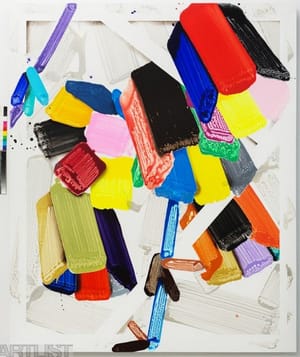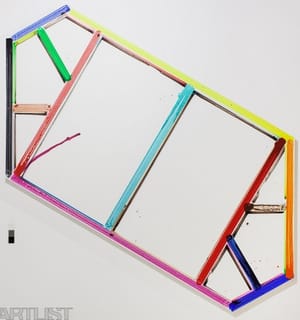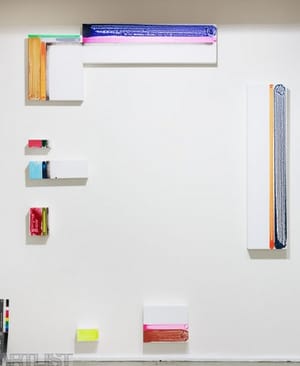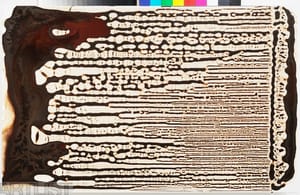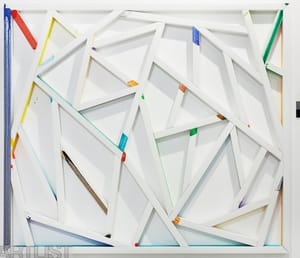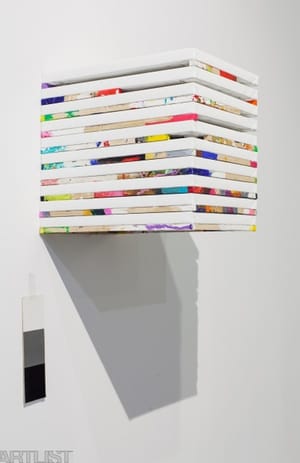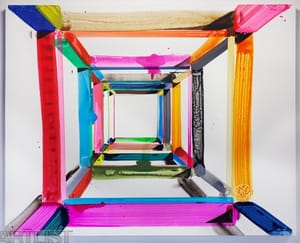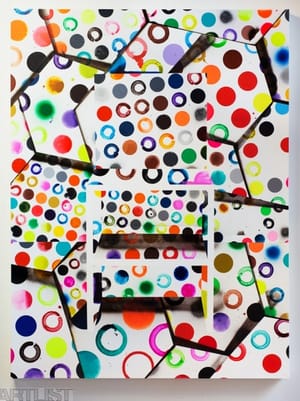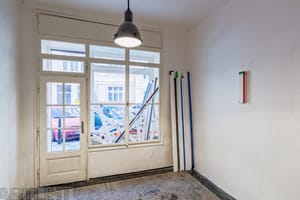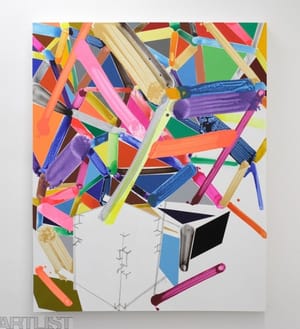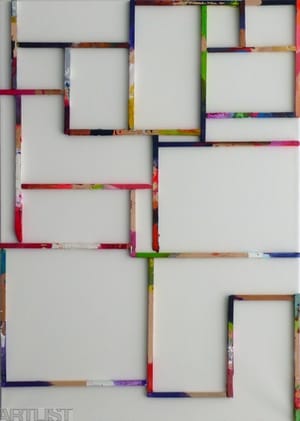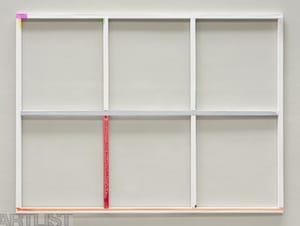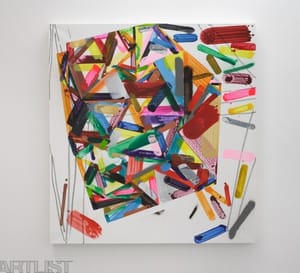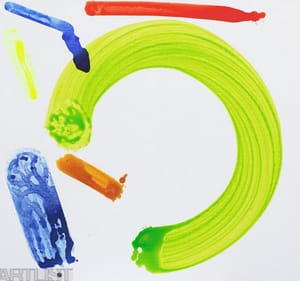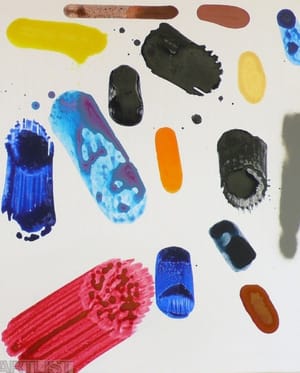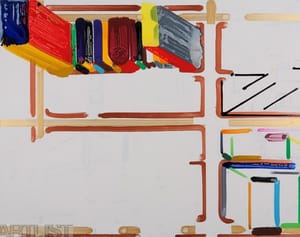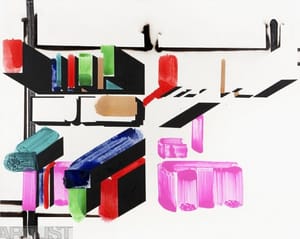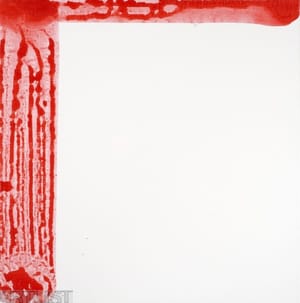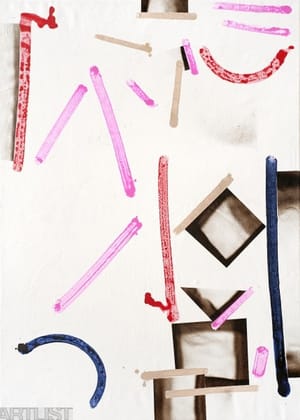- First Name
- David
- Surname
- Hanvald
- Born
- 1980
- Birth place
- Liberec
- Place of work
- Liberec, Prague
- Website
- www.davidhanvald.com
- Lived and worked in
- Liberec, Prague
- Keywords
- CSU Library
- ↳ Find in the catalogue
About artist
David Hanvald is a painter whose work evolves in logically connected cycles that develop relatively fixed principles and a creative logic in a variety of ways that he discovered for himself in the Stanislav Diviš studio at the Academy of Arts, Architecture and Design. Hanvald’s work tends to be systematic and rational in its approach to the construction of images and the investigation of the possibilities of painting. His pieces are based on a painterly reinterpretation of modernist creative forms (be this painting, object, event, photograph or typography) and a grasp of everyday objets trouves in these media. However, although his painting relates to El Lissitzky or a children’s playkit, there is a great deal of ambivalence ensuing from the process of analysis and a method of treatment that is never completely closed. Hanvald’s works are often balanced on the boundary between visual flatness and spaciousness, geometric forms and expressive painterly gestures, abstraction and depiction, conceptual and sensual.
Considerations regarding the properties of painting are clearly based on the tradition of modernism, whose task as the supposed apogee in the evolution of creative forms was to find the specificity of media, at least according to the well known theory of Clement Greenberg and his supporters. The development of art in the 20th century was characterised by a certain amount of newly acquired autonomy and self-referentiality associated with it: creative forms now – though not always and only to a certain extent – developed in accordance with their own laws and reacted one to the other. Hanvald’s work continues in this tradition though understandably absorbs the “innovations” of postmodernism, such as the explicit appropriation of the works of older artists, the inconsistencies referred to already, the ludic quality, and the willingness to leave things open ended. If we speak of Hanvald’s work as being an example of neo-modernism, as Martin Dostál, the painters’ court theoretician coins the term, we do not mean the slavish following of modes, strategies and opinions, but the free thinking about theoretical findings and their formal manifestation in the work of modernist artists [see for instance Martin Dostál, Upgrade – From Louis Kahn to Sol LeWitt Bruce Nauman nevyjímaje, davidhanvald.com, 2011, http://www.davidhanvald.com/2011%20Upgrade%20Od%20Louis%20Kahna.html, referenced 2 June 2015.]. Reflections on modernism are a strong tendency in contemporary, not only Czech, art. In this sense we could place Hanvald’s work alongside that of artists from his closest circles, i.e. other members of the Obr group (Josef Achrer, Martin Krajc and Karel Štědrý), as well as artists such as (to pluck names at random) Vladimír Houdek, Alice Nikitinová, Josef Mladějovský, Evžen Šimera and Vasil Artamonov and Alexej Klyukov, who all, albeit in their own way, represent the legacy of modernism.
The works of renowned artists that nowadays form the canon of modern art serve Hanvald as the starting point for a dialogue with the creative forms of the past, as well as for a composition of the image almost completely independent of its predecessors. In this respect Martin Dostál speaks of deconstruction and construction as being the fundamental method of Hanvald’s oeuvre [see for instance Martin Dostál, Fuck, that’s beautiful!, davidhanvald.com, 2014, http://www.davidhanvald.com/2014%20Do%20prdele%20to%20je%20krasa.html, referenced 2 June 2015.]. And yet in the process of deconstruction modernist works lose their original ethos: a visionary or spiritualistic accent typical for modernism. This principle is already visible in Hanvald’s graduate work, the series Systém, konstrukce, řád / System, Construction, Order (2008–2009), which draws on the architectural designs of Louis Kahn. In this cycle his characteristic style is crystallised with self-assured, strong brushstrokes and expressive colours that in this case are in contrast to the strict rationality of the model. A tension reigns between the surface and space: the gestural quality of the painting and the emphasis on its abstract quality are confirmed by the two-dimensional canvas, while the overall composition defies this and evokes the illusion of three dimensions. Hanvald develops this investigation in the series Objekty / Objects (2009–2010) and Židle / Chairs (2010–2011). In the first he introduces the minimalist objects of Sol LeWitt and Donald Judd into paintings. In the second, inspired by A Cast of the Space under my Chair by Bruce Nauman, he constructs another famous chair designed by Marcel Breuer or Josef Hoffman, whose fixed form is completely absorbed by an almost ornamental, colourful geometric form created with firm, emphatic brush strokes. Both the chairs and objects represent for Hanvald an opportunity for formal experiments that can then serve the informed viewer as a starting point for interpretation and an understanding of the artist’s methods and intentions. At present David Hanvald is playing with historical styles and his pictures are at the same time an affirmation and negation and mockery of gestural painting, minimalism or post-painterly abstraction. However, a knowledge of art history is not a prerequisite for viewing and appreciating Hanvald’s works and several of his cycles do not work with specific prototypes. In the series Stavebnice / Construction Set (2008), Kostky / Building Blocks (2009), and Lidová dovednost / Human Skill (2014) the artist uses objets trouves, while in the cycles Tahy / Moves (2009) and Monochromy / Monochromes (2014) he isolates the basic painterly techniques: brush stroke and intensity of colour.
In other works spaciousness plays a crucial role. In the series Rámy / Frames (2009–2014), responding to the work of Sigmar Polke, Hanvald accentuates the auxiliary structure of the (blind) frames, while in the series Kunsthistorie / Art History (2011) he creates layered suspended objects from individual canvases. Such reflections on the materiality and objectiveness of a painting are relatively common on the contemporary art scene. Like Hanvald in the assemblages in the cycle Art History, Samuel Paučo has been using and emphasising the sides of the canvas in his recent works, while Eva Škrovinová works with the frame as an independent semantic element. The occasional selection of unusual shapes for his canvases, personal, locally specific installation venues, or direct overlaps from painting to installation as a medium (e.g. the exhibition Die Konstruktion in Berlin Model in Prague, 2012) demonstrate Hanvald’s interest in the spatial character of painting.
Typography, especially the book covers by Karel Teige, was subject to reinterpretation. Hanvald abstracts his models while retaining the basic organisational space and thus evokes the aesthetic qualities of coloured surfaces and a specific graphic classification. One could argue that in these works he enters into dialogue with American neo-Dadaism and geometric abstraction, since like Jasper Johns, Kenneth Noland and Ellsworth Kelly, Hanvald goes to the very limits of that which can be depicted before being refracted into purely abstract composition. This residue of the prototype (not necessarily a real object) is retained, as does its highly inconsistent reflection. If in the case of typography Hanvald isolates the method of composing colour surfaces, when being inspired by Czech modernist photography (Jaromír Funke, Josef Sudek, etc.), in the cycle 30. Léta / The Thirties (2013) the theme of his painting is light and shade and their interplay. He selects yet another element, this time an expressive line, from the works of Václav Špála for the cycle Moderní modernita / Modern Modernity (2014).
Although Hanvald draws on a wide range of inspiration that he quotes to some degree or other in his works, he always handles his derived motifs, shapes, compositions or styles with a great deal of invention, transforming them into his own characteristic means of expression, one which is instantly recognisable, intelligible and aesthetically appealing.
- Author of the annotation
- Klára Stolková / Peloušková
- Published
- 2015
CV
2003–2009
Academy of Applied Arts in Prague, at.malby Doc. Stanislav Divis and MgA. Aldina Popa
2001–2002TU Liberec
2000–2001FVU, Ústí nad Labem
1996–2000School of Applied Arts in Jablonec nad Nisou
symposium:
20121st Symposium Litomyšl (Young Stars) Litomyšl
19th Fine symposium Mikulov, Mikulov
20092nd Symposium Kvilda
20055th Symposium of contemporary art, Kutná Hora
6th International Symposium of art academies, Klatovy /
- Member of art groups not included in ARTLIST.
- Obr. (Josef Achrer, David Hanvald, Martin Krajc, Karel Štědrý; zal. 2006) CLAN (Stanislav Diviš, David Hanvald, Karel Štědrý, Aldin Popaja; zal. 2010)
Exhibitions
- Solo exhibitions
-
2015
Táhni štětkou!, Galerie Petr Novotný, Praha
2014
Rukopis převzít nejde!, Galerie Dole, Ostrava
Do prdele, to je krása!, Galerii Die Aktualität des Schönen, Liberec
2013
Když má něco vypadat dobře, tak to dobře vypadá, GASK, Kutná Hora
Akryl, plátno, Hanvald galerie NOD Roxy, Praha
2012
Die Konstruktion, Berlínskej model, Praha
Der echte Hanvald, Galerie České pojištovny, Praha
hanvaldkunst, galerie Petr Novotný, Praha
The Brick, galerie SPZ, Praha
2011
Kunst – historie, Collection etY, Praha
hanvaldkunst, galerie ad-astra, Kuřim
Upgrade – Od Louis Kahna k Sol LeWittovi, Bruce Naumana nevyjímaje, Dům umění ČB, České Budějovice
2010
Řádná malba, Galerie Caesar, Olomouc (s K. Štědrým)
Systém, konstrukce, řád, Richard Adam Gallery, Galerie Za stěnou, Brno
2008
Klíčové krajiny, Galerie GFJ, Kutná Hora
- Group exhibitions not included in ARTLIST.
-
2015
Od obrazu k objektu, Galerie Gagarinka, Bratislava (SK)
Od podlahy, Galerie Emila Filly, Ústí nad Labem; Cargo, Galerii Die Aktualität des Schönen, Liberec
2014
Zlatý věk – Reminiscence kubismu v současném umění, Dům umění, Brno
Zářivý krystal – Průniky, střety, přesahy, GVU v Ostravě, Ostrava
2013
Kostlivec v rajské omáčce, Richard Adam Gallery, Brno
Obrys, Dům umění, Brno
2012
Metaplay. Galerie Kritiků, Praha
Citace a interpretace II. – malba, Galerie NOD Roxy, Praha
Zahrady malby - současná česká malba ze sbírek Richard Adam Gallery v Brně, Galerie P. M. Bohúna, Liptovský Mikuláš
2011
Česká malba generace nultých let 21. století, Richard Adam Gallery, Brno
Ztišeno, Richard Adam Gallery, Brno
Obr., galerie NOD ROXY, Praha
2009
Obr. Krychle, Klárov, PrahaStart point, Galerie Klatovy / Klenová
V. Zlínský salon mladých, Dům umění ve Zlíně
Obr. na písku, Tranzit dielne / Workshops / SK, Bratislava (SK)
2008
Obr. , Galerie Mánes, PrahaCZ – SK, Richard Adam Gallery, Brno
2007
Obr. v Louvru, Praha - oficiální založení výtvarné skupiny Obr.
Designblok 07, Praha
2006
Trafačka, Tovární hala Trafačka, PrahaMěsto, galerie AVU, Praha
2005
Contacts, galerie Klatovy/Klenová sýpkaVěcne hladní, Haly Studená ( tranzit ), Bratislava (SK).
- Collections
- Oblastní galerie Liberec Galerie FJ. města Kutné Hory Richard Adam Gallery (Wannieck gallery) Galerie Klatovy / Klenová Soukromé sbírky v ČR, AU, DE
- Other realisations
2005 realizace nástěnné malby podle návrhu Zdeňka Sýkory,
Mezinárodní středisko letového prostoru v Jenči
Monography
- Monography
Obr.: [Josef Achrer, David Hanvald, Martin Krajc, Karel Štědrý. [Praha]: KANT, 2012. [96] s. ISBN 978-80-7437-046-5.
CLAN a TUČKOVÁ, Kateřina. Clan: Diviš, Hanvald, Popaja, Štědrý: 2.12.2010-9.1.2011, Výstavní síň Chrudim v Divadle Karla Pippicha. Chrudim: Chrudimská beseda, 2010. [32] s.
GALERIE CAESAR a DOSTÁL, Martin. David Hanvald, Karel Štědrý: řádná malba. Olomouc: Galerie Caesar, 2010. [7 s.].
HANVALD, David. David [Hanvald]. [Praha]: Arskontakt, 2009. 79 s. ISBN 978-80-904288-2-9.
- Articles
TUČKOVÁ, Kateřina. Malba v rozmezí CZ - SK. Art+Antiques, prosinec 2008.
TUČKOVÁ, Kateřina. David Hanvald. Art+Antiques, červenec-srpen 2008.
SLÁDKOVÁ, Hana. Jak se peče obr.?. A2. č.19 / 2007.
